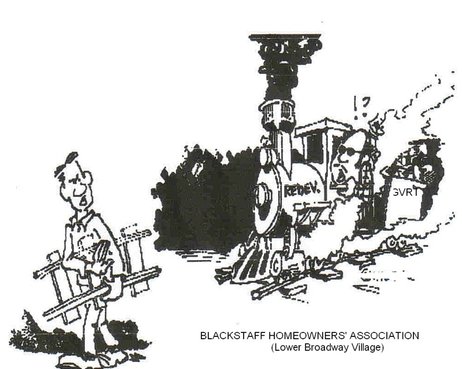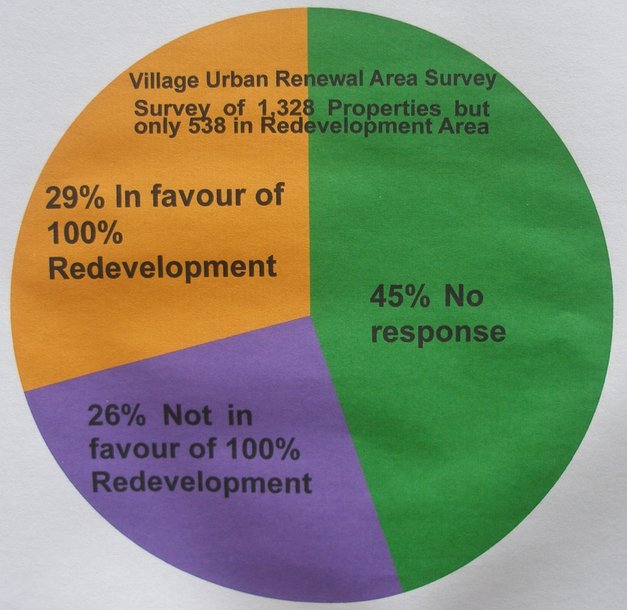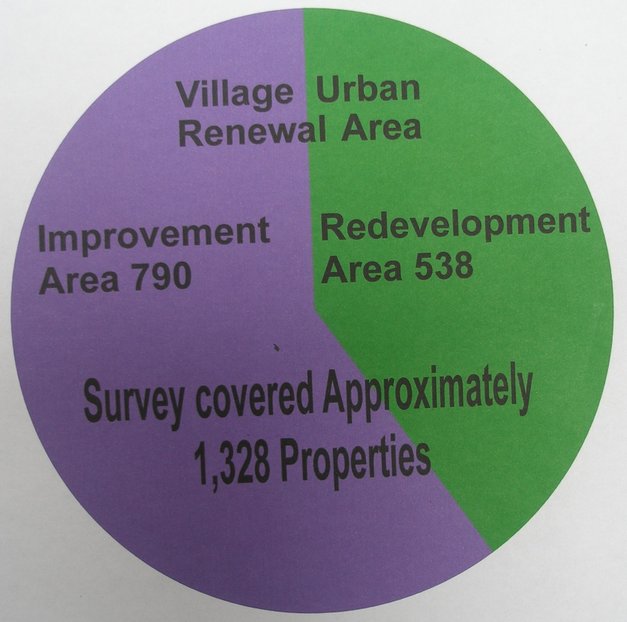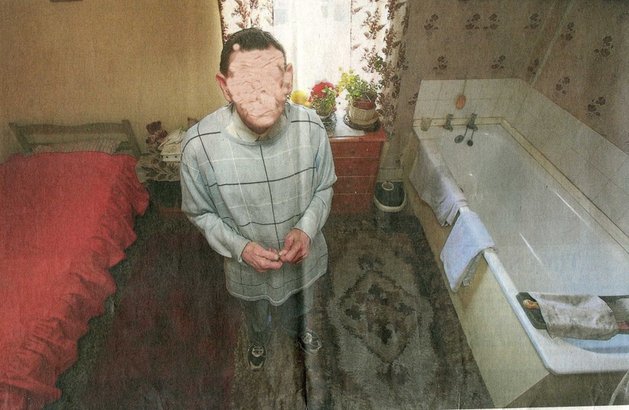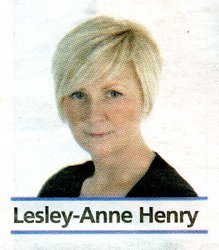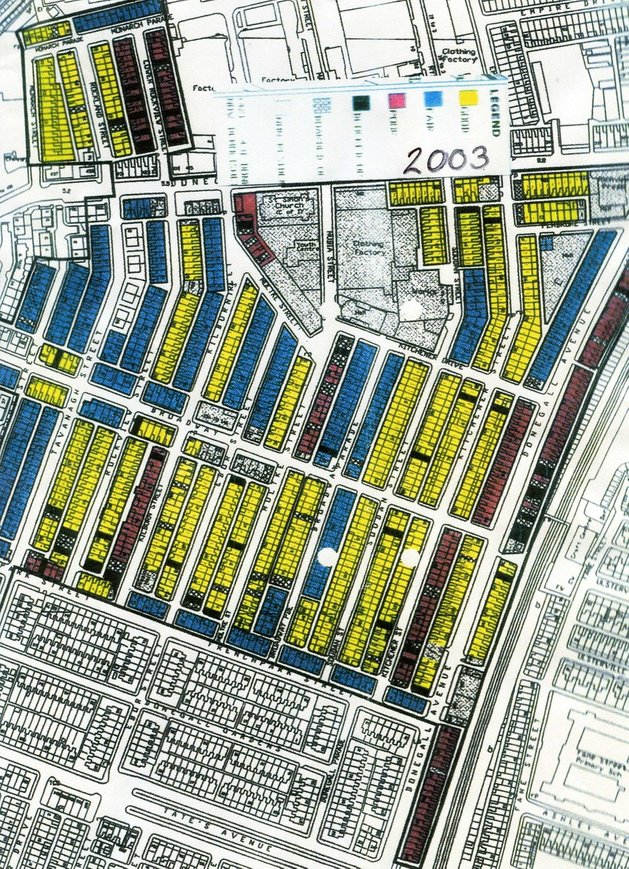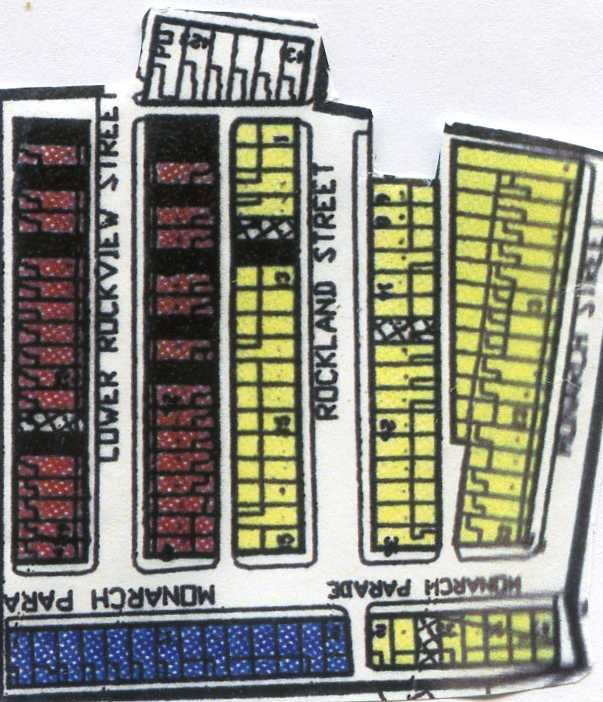BLACKSTAFF COMMUNITY DEVELOPMENT ASSOCIATION
(BLACKSTAFF RESIDENTS)
The Battle To Save Our Community
The Fight Against Full Redevelopment
ORIGINAL LETTER OF OBJECTION
‘Before deciding to proceed with redevelopment, we will consider all the other possible options, their costs and benefits.‘ This was never the case and residents were never given the opportunity to put forward other possible options for consideration. Had they been asked; one option would have been to keep and refurbish the terraced houses within an overall design plan, which might include some new build.
We understand that homes were visited up to 6 times to get an answer and even then the response rate was only 55% and within the 55%; 26% were not in favour of full redevelopment. Add the 26% to the 45% who did not respond and you get 71% who neither supported full redevelopment or wanted to get involved in the survey.
BCDA would also point out that these figures are based on a survey of approximately 1,328 properties , whereas the redevelopment area consists of 538 properties. Option ‘6’ in the Consultation Survey was termed the ‘GVRT Option’ and this was for 100% redevelopment.
IT IS INCREDIBLE THAT A GROUP ADVOCATING 100% REDEVELOPMENT FROM THE VERY START SHOULD CARRY OUT THE CONSULTATION PROCESS.
It is incredible that a group advocating 100% redevelopment from the very start should carry out the consultation process. The GVRT and Housing Focus Committee have carried out an aggressive campaign in support of the 100% redevelopment option for the area, and this has been demonstrated in the media. Their campaign have made residents very apprehensiveof expressing their views.
BCDA made a suggestion in their submission at the Planning day held in Wellington Park Hotel on Monday, 9th July 2007, that they should be given the resources to produce a publication supporting the case for terraced housing, as those who support redevelopment for the area have already been given every opportunity and resources to put forward their views. BCDA and Homeowners' Association received no support.
A number of requests were made to meet the Minister for Social Development, Margaret Ritchie before she finally received a deputation in July 2008. The Minister left the meeting very early, leaving her officials to go through the agenda.
MARGARET RITCHIE NEVER HAD A FULL MEETING WITH THE BLACKSTAFF HOMEOWNERS
This is in stark contrast to the amount of time she gave to non-residents and groups supporting redevelopment. BCDA and Blackstaff Homeowners' Association were left to struggle along with no help, while glossy publications by GVRT, supported by the Northern Ireland Housing Executive (NIHE) and funded by the Department for Social Development (DSD) continued to promote redevelopment.
There was also the issue of the use of NIHE and DSD logos on leaflets produced by groups supporting full redevelopment. This gave the misleading impression that views and actions were supported by NIHE and DSD. When we complained, the NIHE wrote to groups, stating that their logo was not to be used without permission.
Public meetings were held by the GVRT inviting everyone from the Blackstaff Ward to attend. This resulted in many ‘outsiders’ having a say in what shoud happen to our homes. This has even extended to the GVRT’s Housing Focus Committee, were two members, including the chairman who lives in the Olympia area.
There is no need to demolish such a large area of housing which we view as discriminatory. The scheme proposes demolishing perfectly good houses along with those that might be seen as being in poor condition and condemns our homes which we view as unjustified
Dividing the area in two with an arbitrary line makes no sense.
The claim by Paddy McIntyre, Chief Executive of the Housing Executive that the vast majority of houses are over 100 years old is not true.
Adverse publicity in the media of poor housing, does not relate to our area. The claim by Paddy McIntyre, Chief Executive of the Housing Executive that the vast majorityof houses are over 100 years old is simply not true and we would dispute other claims about the number of bricked up houses.
Our members have affordable and comfortable homes which they have maintained to their satisfaction. They do not wish to see their homes vested and taken from them. In their present situation, they have security and peace of mind. With full redevelopment, they have only concerns about the future, due to so much uncertainty. BCDA see no justifiable reason why our members homes should be vested by the NIHE.
The redevelopment scheme will cause many neighbours to be rehoused away from each other. (This has already happened throughour 2009) This will destroy the good neighbourly support that they experience on a daily basis. There is nothing in the redevelopment scheme that would be of any benefit to any of our members.
It is our belief that, that the older generation will be sacrificed for a younger generation who will benefit in purchasing new homes, built where our homes once stood. The younger generation may not necessary have any family connections to the Blackstaff Ward. On the first day of the public inquiry, it was said in evidence by a member of the Housing Focus Committee that the 'SENIOR CITIZENS DAYS ARE NUMBERED'. This statement only adds to our view that the older generation will be sacrificed for a younger generation. It is not regeneration it is new generation.
As already stated, BCDA would support an option to keep and refurbish the terraced houses within an overall design plan, which might include some new build, but this option was never put to the community for consideration.
Before any talk of redevelopment or regeneration, the area wassteadily regenerating itselfwith minimum expense to the public purse, and houses were in great demand until the recession and the declaration of an Urban Renewal Area. There was considerable demand for the existing houses in the area. Leaflets were 'flooding' into our homes every week - offering to buy them with a wide range of options including the opportunity to buy back.
The average price paid for a terraced house in the Blackstaff Ward had risen to £150,000.Such was the demand for terraced housing that even those in the poorest condition had risen in price and 'shells' of houses had sold for similar prices to those in good condition. and furthermore prices of older houses had matched those of houses built from the 1960s.
These facts should have caused the N.I. Housing Executive to look again at the findings of the Economic Appraisal. Even after the declaration of a housing renewal area, a number of houses were renovated. A house in Broadway Parade had recently received planning permission for a double extensionand at the same time another house in the same street had just been completely renovated with a double extension included. The same examples can be seen in every street within the Urban Renewal Area.
Option ‘6’ in the Consultation Survey was termed the ‘GVRT Option’ and this was for 100% redevelopment. This option was referred to at a public meeting in Donegall Road Primary School as the 'Community Option'. We repeat, it is incredible that a group advocating 100% redevelopment, from the very beginning should carry out the consultation process.
The GVRT have carried out an aggressive campaign to get 100% redevelopment for the area, and this has been demonstrated in the media. Their campaign has made many residents apprehensive about expressing their views.
As we have already mentioned, publicmeetings were held by the GVRT inviting everyone from the Blackstaff Ward to attend(approximately 50 residential Streets, representing 2036 houses) This resulted in many ‘outsiders’ having a say in what happens to our homes.
The arbitrary decision to draw a line dividing the area into two, will mean demolishing perfectly good houses along with those that might be seen as being in 'poor' condition. A decision to demolish should not be made on percentagesbut based on which houses (if any) need to be demolished. There can be no logical case for simply drawing a line between 40% and 60%. Our suspicion for the arbitrary line, is that the Lower Broadway Village area will be the most attractive to private investors as it is closest to the Lisburn Road area and Methodist College.
Many residents have shown faith in the area during the worst times of 'the troubles'. We have suffered much, but we refused to leave, hoping that good times will come back again. Blanket redevelopment is a betrayal of our community and a slap in the face in exchange for all our past efforts.
The area has seen a lot of improvements from 2005, and various descriptions of the area by the NIHE have no relevance to the area earmarked for redevelopment. We have never found anyone at any of our meetings or in general conversations with residents who said that the inside of their home was inspected to determine if they were fit or unfit. The claim by Paddy McIntyre, Chief Executive of the Housing Executive that the vast majority of houses are over 100 years old is not true.
WHY SHOULD WE BE FORCED TO PART WITH OUR GOOD HOMES IN A RECESSION?
Our Association has asked many times for elected representatives to call at random and visit about seven homes or more to find out the views of local people.
The aggressive campaign by those who favour 100% redevelopment has made many unwilling and even afraid to express their views.
Albert Einstein once said: “The definition of insanity is doing the same thing over and over again and expecting different results.”
Redevelopment has destroyed many communities throughout Belfast and contributed to the decrease in Belfast’s population.
Homeowners living in the Blackstaff ward of south Belfast are concerned that their homes will be taken off them without good reason. Within the Blackstaff ward, there are a number of separate areas, two of which are the Village and Monarch. Part of the Village and all of the Monarch area are included in what is known as the Village Urban Renewal Area (URA). It has been proposed that 60% of the housing is to be demolished and replaced with new housing and that 40% be refurbished. Regarding this: there was some confusion among groups as to the area covered within the 40%. There was general agreement on the 40% but when it was announced that the 40% would be confined to one section of the area there was serious disagreement among all groups and especially The Blackstaff Homeowners' Association and Blackstaff Community Development Association. We as members of Blackstaff Community Development Association believe there is still room within the agreement for compromize. We must be looking for better ways to proceed and it was our hope that the public inquiry would have given food for thought and a new and better approach to solving the problems.
The Northern Ireland Housing Executive (NIHE) states that there are 538 properties within the URA. 30 properties are blocked up and 59appear to be vacant.
Homeowners have watched helplessly as active campaigners demanded the destruction of their homes, to be replaced by large family homes with large gardens. The majority of the community, who are senior citizens, believe that they are being sacrificed for a younger generation. As far as we are concerned, regeneration simply means new generation.
There have been many statements in all kinds of publications, emails and letters regarding the consultative process being community driven and that residents have initiated the process along with the NIHE and the Greater Village Regeneration Trust (GVRT). The facts are that people outside the Urban Renewal Area have been at the forefront of the campaign for 100% redevelopment and have called themselves local residents. They are indeed residents of the Blackstaff ward but most are not residents of the Urban Renewal Area.
The process of redevelopment was never agreed to by the local residents and the arguments for redevelopment were made most aggressively by non-residents.We have constantly stressed that only local residents should have a say in what happens to their homes. Why should outsiders have a say in what happens to our homes? Why should outsiders campaign for the demolition of our homes?
The majority of residents are of the older generation: a generation that worked hard in order to own their own homes and to bring up their families. They want to remain in their homes and fear for the future. Regrettably many have moved out because thir families were concerned that their loved ones were living beside blocked up houses. 'Mum, you will have to move eventually and it might be best if you moved now'. This was the kind of general remark made during family discussions. One lady committed suicide because she felt she was being forced out of her home. This was said by her daughter in a BBC Talkback programme.
We can’t understand why our homes are declared unfit, when very few have been inspected from inside. We have not found any of our members who said their home had been inspected from inside.The situation must end where people don’t have inside toilets or bathrooms, but this is no reason to demolish their homes altogether.
Why should houses in Kitchener Street be demolished, while similar houses in the same street are to be refurbished because they are of “townscape character”? If certain houses can be saved because they are of townscape character, then why should similar houses be demolished in the same street?
We also can’t understand why the NIHE keep insisting the houses are mostly over 100 years old. Such information is repeated on the organisation’s website as well as in their printed material. For example, in a news release on 1 May 2008, Paddy McIntyre, the chief executive of the housing executive, wrote that “the vast majority of houses are over 100 years old” and so therefore “fall short of modern standards”.
Paddy McIntyre has come as near to the truth as anybody has of hitting the moon with a stone. It is commonly known that the 100-year-old houses are confined mostly to Donegall Avenue, while the rest of the area consists of houses that date from 1930 to 1935. A casual look in the Belfast central library at street directories, going back to 1908, will confirm what we are saying and that MLAs (Members of the Legislative Assembly) and everyone else have been fed misleading information.
The NIHE’s views have been backed up by the television reports showing images of 'poor' housing in the streets around Windsor football ground.This area is well outside the Village URA and, again, misleading information.
Part of the campaign for redevelopment has been to show the worst possible views of poor housing and to give the impression that they were typical of housing generally throughout the area. It did not even matter if the properties were outside the URA as it made a good story for the press and TV.
Man with a bath in his bedroom
Remember the man with the bath in his bedroom?The Belfast Telegraph and the Nolan programme on BBC radio both ran the story highlighting the man's situation.
The cry rang out that “something must be done”. Now this might come as a surprise to many, but this man’s home is not even in the Urban Renewal Areabut in Olympia (near Windsor Football Ground). How could anyone get it so wrong? The media clearly saw this as a good story. Was the media contacted to put the record straight? Did the homeowners try to get their views across? Yes we did. We tried many times, but no one wanted to know.
“People living without electricity”
Rumours and press reports of people living without hot water and electricity were the norm. Blackstaff Community Development Association wrote the Belfast City Council Health and Environmental Services Department and the Housing Executive to find out how many cases were reported to them. The City Council Health Department said that they were currently only dealing with one complaint concerning an unfit house in the village area and went on to say that they were not aware of any other referrals from community workers in the area with regards to unfit houses. Nor had they received any complaint concerning people living without electricity in the area. The Housing Executive District Manager wrote that he was unaware of the number of people in the Village area which are living in accommodation which has no electricity. He also went on to say that he was unaware that people are moving out as they cannot live in the conditions of these dwellings.
Advance purchase
The NIHE website and a publication, delivered to every home in the URA in November 2008, provided this information:
"If you plan to sell your home and become awarethat the Housing Executive is considering a redevelopment scheme in your area, you should contact your local office without delay to obtain advice. In some special circumstances, we can purchase property before the formal approvals have been obtained, in order to help speed up the redevelopment process."
What proof did homeowners have to give to the NIHE that they were currently planning to sell their homes? How many homeowners did the NIHE turn down because they were not currentlyplanning to sell their homes? What about special circumstances? It is our view that the advance purchase scheme was wrongly used to expedite redevelopment.
We understand that many homeowners have been panicked into going for advanced purchase, because they feared for the future. The houses that have been vacated are among the best in the area. Some have even under floor heating. The majority have been blocked up despite constant protests from the homeowners. In regard to the blocking up of good houses the Blackstaff Homeowners' Association at a meeting in Parliament Buildings on 1st April 2009 gave the South Belfast MP, Dr. Alasdair McDonnell proposed written guidelines for the securing of empty properties. The main aim of the guidelines was to get the NIHE to consult with local residents regarding the securing of empty properties. Our MP promised he would hand the proposed guidelines to the DSD Minister, Margaret Ritchie MLA. To date we have not receivedany written acknowledgement to our suggestions. We are now seeing a repeatof what happened to many areas in the past. The community is very slowlydisappearingaround us, but it is not too late to do something about it.
Those who have decided to jump might have been fortunate in financial terms — if nothing else — as area valuation was highest when they decided to take advantage of the advanced purchase scheme. However, it will be worse for the rest of the homeowners as house prices have since fallen. The University of Ulster’s quarterly house price index revealed, on 17 November 2008, that the average house price in Northern Ireland has slumped by £46,881 over the last 12 months, meaning the average house has fallen in value by £128 a day.
Homeowners were forced to cancel their meeting
Residents afraid to express their views
The aggressive campaign by those in favour of 100% redevelopment has made many unwilling and even afraid to express their views. This is understandable as anyone who has openly voiced an opposing view has experienced their serious aggression.
This aggression has been witnessed by officials of the NIHE and the Department for Social Development (DSD). Homeowner meetings have been gatecrashed and foul language has been used against those attending the meetings. One meeting of the homeowners was “cloned” by those in support of redevelopment by leafleting the area calling for everyone to attend the meeting in support of 100% redevelopment. Homeowners were forced to cancel their meeting and thereafter our meetings were restricted to members only.
The chairman of the Homeowners’ Association, Billy Dickson, was the main target for many of those supporting redevelopment. Community Television was used to attack him, on the grounds that he was opposed to redevelopment because he was a landlord. This is simply not true, and even if it were true, what difference would it make?
We believe some MLAs have caved into this pressure, including the south Belfast SDLP MP MLA, Alasdair McDonnell. On 22 January 2008, the DUP MLA for south Belfast, Jimmy Spratt, was harassed on the steps of the parliament buildings by protesters.
Jimmy Spratt supported some of the views expressed by homeowners at a Northern Ireland assembly debate on 10 March 2008. But we believe that many public representatives are reluctant to get involved. Some have never voiced an opinion in public. For this reason, homeowners — many of whom attended the assembly debate — feel they have been “sold out” by their public representatives.
Within the community, there is also a fear of speaking out. For example, one professional person ended a letter to an MLA with these words: “I respectfully request that my name and other details not be made known … like many residents, I am apprehensive about the ‘methods’ they [redevelopment campaigners] would be prepared to employ to attain their goals.”
This is a letter we received, which I have left unedited.
Thank you very much for your fight against the proposed redevelopment of the area. It has took us years to build up the way we want it, and like a lot of people I have talked to about the moves are really dreading it, we thank you or whoever, got the number of houses (Door Numbers) and visit people Yes or No to house being destroyed, I think you will find is a lot of older people, lived here all their lives, and would not mind renovate of houses that can be done, also we are really worried where we will be moved, and neighbours for years broke up. I am sorry for not giving names and address.Thank you. Worried Village Resident. Good Luck.
It seems clear to us that local homeowners have been subjected to an unrelenting campaign against them, causing many — including public representatives — to be cowed into silence.
Perhaps the most serious case of misinformation
'A lick of paint is not all that is needed'
Perhaps the most serious case of misinformation, we believe, was designed to damage the reputation of the Homeowners’ Association and Blackstaff Community Development Association. It was spread throughout the community that Billy Dickson, as chairman of both associations, had made the statement that “a lick of paint is all that is needed”.
This was followed by the headline in the South Belfast Community Telegraph: “The Village needs more than a lick of paint, says GVRT.” It became a talking point throughout the area and was unfortunately believed by many, causing us considerable hurt and damage.
The reference to paint was taken from a lengthy submission made on behalf of the two Blackstaff Associations at a planning day, held in Wellington Park hotel on 9 July 2007. A number of organisations were present and some made submissions, including the GVRT. In one small section of our submission the following was stated: ‘…the condition of many houses and the environment continues to cause the greatest concern for the community. A walk along each street will give mixed messages. Why should many houses and gardens look so good and others look so bad? Many residents get depressed at the deplorable state of many doors, windows and gardens. It is only when they look up at the brickwork that they realise that they are good houses. It is hard to ignore old telephone books and other rubbish that litter many gardens. The houses that are well maintained show just what can be achieved. An architect, at a recent meeting of the Blackstaff Homeowners’ Association referred to these houses as not being “switched on”. They are like the blank television screen without the TV programme. Many of these houses are lived in but the occupants do little to improve their appearance. Usually a lick of paint (as we say) and a weekly brush and tidy to the front garden area would make such a difference.' Notice the context in which the “lick of paint” is mentioned!Everyone at the planning day, including the GVRT, heard the submission and all were fully aware of the context in which the reference to paint was used and who said it.
Every effort to meet the NIHE board and the minister for social development was either ignored or rejected
Defending decent terrace housing from unwarranted demolition
We made the suggestion in our submission at the planning day that we should be given the resources to produce a publication supporting the case for terrace housing, as those who support redevelopment for the area have already been given every opportunity and resources to put forward their views. We received no support.
Contrast this with a report of workshop held in 2007. The workshop provided a lot of information for those opposed to unwarranted demolition of terrace housing. We only recently became aware of this workshop, by accident. This information would have proved invaluable to us.
We were left to struggle along with no help, while glossy publications by the GVRT, supported by the NIHE and funded by the DSD, continued to promote redevelopment.
We feel we have not been treated fairly and that our case has never been given the same opportunity or conditions that would have been conducive to producing a detailed alternative to demolition.
On 4 May 2006, we wrote to Brian Rowntree,
chairman of NIHE board,
Every effort to meet the NIHE board and the minister for social development was either ignored or rejected, and when the minister finally agreed to receive a deputation, it was too late and she only stayed a short time.
requesting a meeting with the board. This request was rejected but in stark contrast, the board accompanied by the Chief Executive and senior Directors met GVRT on 10th February 2005. Mr Brian Rowntree said the visit was invaluable. Mr Liam Kinney talked about involving local people but within a year the board refused to meet the local people.
...there should not only be direct involvement with residents but we should feel in control of our own destiny
A number of requests were made to meet the minister for social development, Margaret Ritchie, before she finally received a deputation in July 2008. The minister left the meeting very early, leaving her officials to go through the agenda. This is in stark contrastto the amount of time she gave to non-residents and groups supporting redevelopment.
The meeting proved useful in a number of ways, but had no bearing on the decisions already made. It was too late. It also confirmed that the NIHE would continue to use the GVRT as the main conduit for community opinion. In our opinion, this is one of the main problems — there should not only be direct involvement with residents but we should feel in control of our own destiny. It should not be for non-residents to determine what should happen to our homes and where we should live.
Millions of pounds are needed to deal with the housing problems throughout the Blackstaff ward area. Our resolve is to make sure that homeowners and everyone else will be treated fairly and that there will be a development plan that will keep the community together. Unfortunately signs are not good as many houses have already been blocked up in a number of streets, and this is before vesting.
Despite protests by Blackstaff Homeowners’ Association against the blocking up of good houses, the NIHE has continued to do so. They could remain blocked up for 10 years or more. Among the first houses blocked up are a few in Frenchpark Street.There is absolutely nothing wrong with the 28 houses in the street, which the NIHE have earmarked for demolition.
What is the logic behind demolishing 28 perfectly good houses? When is this madness going to stop?The claim in May 2008 by Margaret Ritchie, the minister for social development,that this process is being taken forward in consultation with the local community is evidently not true.
Frenchpark Street -
Why would anyone wish to demolish these good houses?
LEGEND:GOOD -FAIR -POOR - BLOCKED UP
THE VILLAGE REDEVELOPMENT AREA
WHERE ARE THE 580 UNFIT HOUSES ?
THE MONARCH REDEVELOPMENT AREA
The Donegall Pass Forum website provides 25 photographs of the so-called Village Residents' Protest on 20th April 2007 at Broadway. The media and all not familiar with the area were fooled into believing that the protesters were from the Village Urban Renewal Area. Genuine local residents who have studied these photographs can clearly identify 4 residents from what is now the redevelopment area and 2 residents from what is now the improvement area. These photographs are still available on the Donegall Pass Forum website ( http://www.donegallpass.org/) and we would ask local residents to inform us if they can identify any more than SIX local residents. We are very grateful to the Donegall Pass Forum for providing the excellent photographic evidence - although we suspect that they too were fooled.
(The above information is taken from a Statement of Evidence presented by Blackstaff Community Development Association. )
In our original letter of objection we stated that it is our strongly held belief, that only a public inquiry will give us the freedom and opportunity of putting forward our case against full demolition. Hopefully we may all see some resolution to our difficulties. This did not happen because...
THE CASE FOR FULL REDEVELOPMENT (DEMOLITION OF HUNDREDS OF GOOD HOUSES ALONG WITH 'POOR' HOUSES) WAS BASED ON UNTRUTHS AND MISINFORMATION. THE PUBLIC INQUIRY WAS TO GIVE US THE OPPORTUNITY TO CHALLENGE THE 'EVIDENCE' ON WHICH SUPPORTERS OF 100 % REDEVELOPMENT AND THE NORTHERN IRELAND HOUSING EXECUTIVE BUILT THEIR CASE. THIS WAS DENIED TO US BECAUSE THE LEGAL REPRESENTATIVE FOR THE BLACKSTAFF HOMEOWNERS' ASSOCIATION FELT HE HAD TO WITHDRAW ON THE FIRST DAY DUE TO THE INSPECTORS OPEN SUPPORT FOR THE REDEVELOPMENT PLANS AND IN HIS VIEW, HE FELT THE INSPECTOR HAD ALREADY MADE UP HIS MIND. THE HOMEOWNERS WERE LEFT WITHOUT A LEGAL REPRESENTATIVE TO CHALLENGE THE 'EVIDENCE' PUT FORWARD BY THE GREATER VILLAGE REGENERATION TRUST AND THE NORTHERN IRELAND HOUSING EXECUTIVE / DSD.
Blackstaff Community Development Association held its inaugural meeting in Kelvin Secretary School on Tuesday, 2nd May 1978. The first chairman was the school's headmaster, Mr Maurice Thompson. Two of the main objects of the BCDA are: (1) To provide a forum where complaints may be ventilated and, by discussion and constructive criticism strive to improve the standard of life for the residents of the Blackstaff Ward. (2) To assist Government Departments, Local Authorities and other bodies, by discussing and giving the possible reaction to schemes proposed; to initiate discussions on schemes which, in the opinion of the association, would contribute to the development of the Blackstaff Community.
The BCDA has been involved in a wide range of issues. In regard to housing, it was instrumental in forming Glenmachan / Tavanagh Housing Action Committee and Roden Street Housing Action Committee. These two committees worked with the Northern Ireland Housing Executive in developing an agreed approach to housing issues in the area. This involved demolishing the worst housing and keeping the best of the old. The result was the building of new houses alongside the existing houses. This policy proved very successful and even the most recent proposals contain a comitment to keep and make possible Improvements to these houses. This commitment is in regard to lower Lecale Street, Benburb Street and Tavanagh Street. These streets are now part of the proposed improvement area. Other excellent examples can also be seen at Connaught Street and Symons Street (not part of the URA). There has also been considerable infill in terraced streets throughout the Donegall Road area and proves beyond a shadow of doubt that a mixed policy of old and new can be successful.
It was our understanding that this policy would then be extended when BCDA helped form a residents committee in May 1986, covering the streets from Tavanagh Street to Moltke Street and also the four Monarch streets. This area was outlined in a NIHE report in June 1988, entitled Monarch / Ebor H.A.A. It however excluded Tavanagh Street.
Unfortunately the NIHE, thereafter adopted a policy of redevelopment and a rejection of an infill option which was supported by the community. It was simply put to them, that if they rejected redevelopment, then they would be left to market forces. Redevelopment was rejected by the community and the NIHE did as they said, and left the community to market forces.
BCDA members were very concerned that this decision by the NIHE would see a deterioration in the area. For a time this seemed to be the case, however there were signs that the area was steadily regenerating itself. The regeneration escalated considerably over the last three years and even seen an increase in the number of young people purchasing homes. Although BCDA was delighted to see the improvements, it was felt that there was a strong need for a clear unified design policy for the area.
The BCDA held a number of meetings, including one public meeting to review ongoing developments. It was finally decided to form a Donegall Avenue / Tavanagh Street sub-committee, consisting of local residents from nine streets. We distributed leaflets asking for volunteers to serve on the committee. After receiving some applications to join the committee, the GVRT announced that it was forming a Housing Focus Committee supported by the NIHE.
The Greater Village Trust’s Community Consultation Survey in 2005, gave residents the choice of 6 options. The NIHE’s general advice and guidance on redevelopment states,
